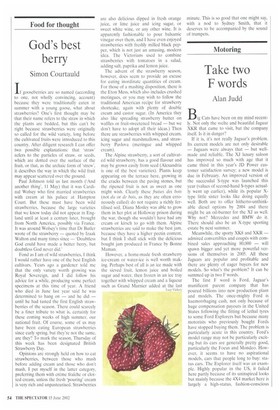God's best berry
Simon Courtauld
If gooseberries are so named (according to one, not wholly convincing, account) because they were traditionally eaten in summer with a young goose, what about strawberries? One's first thought may be that their name refers to the straw in which the plants are bedded, but this can't be right because strawberries were originally so called for the wild variety, long before the cultivated fruits were introduced to this country. After diligent research I can offer two possible explanations: that 'straw' refers to the particles of straw, or seeds, which are dotted over the surface of the fruit, or that, as the archaic form of 'strew'. it describes the way in which the wild fruit may appear scattered over the ground.
Paul Johnson told us last month Mild another thing', 11 May) that it was Cardinal Wolsey who first married strawberries with cream at his palace at Hampton Court. But these must have been wild strawberries, because the large varieties that we know today did not appear in England until at least a century later, brought from North America, possibly via France. It was around Wolsey's time that Dr Butler wrote of the strawberry — quoted by Izaak Walton and many times since — 'Doubtless God could have made a better berry, but doubtless God never did.'
Fond as I am of wild strawberries, I think I would rather have one of the best English cultivars. Years ago a gardener told me that the only variety worth growing was Royal Sovereign, and I did follow his advice for a while, producing some perfect specimens at this time of year. A friend who died in June last year said he was determined to hang on — and he did — until he had tasted the first English strawberries of the season. There could scarcely be a finer tribute to what is, certainly for these coming weeks of high summer, our national fruit. Of course, some of us may have been eating European strawberries since early spring, but they're not the same, are they? To mark the season, Thursday of this week has been designated British Strawberry Day.
Opinions are strongly held on how to eat strawberries, between those who mash before adding cream and those who don't mash. I put myself in the latter category, preferring them with creme fraiche or clotted cream, unless the fresh 'pouring' cream is very rich and unpasteurised. Strawberries are also delicious dipped in fresh orange juice, or lime juice and icing sugar, or sweet white wine, or any other wine. It is apparently fashionable to pour balsamic vinegar over them, and I have even enjoyed strawberries with freshly milled black pepper, which is not just an amusing, modern idea. The Victorians used to combine strawberries with tomatoes in a salad, adding salt, paprika and lemon juice.
The advent of the strawberry season, however, does seem to provide an excuse for eating inordinate quantities of cream. For those of a mashing disposition, there is the Eton Mess, which also includes crushed meringues, or you may wish to follow the traditional American recipe for strawberry shortcake, again with plenty of double cream and castor sugar. (In America they also like spreading strawberry butter on waffles or fruit-sweetened bread — but we don't have to adopt all their ideas.) Then there are strawberries with whipped cream, icing sugar and marshmallows, and strawberry Pavlova (meringue and whipped cream).
The Alpine strawberry, a sort of cultivated wild strawberry, has a good flavour and may be grown easily from seed (Alexandria is one of the best varieties). Plants keep appearing on the terrace here, growing in the cracks between the paving stones, but the ripened fruit is not as sweet as one might wish. Clearly these fraises des bois (not du or de bois, as they are often erroneously called) do not require a richly fertilised soil. Diana Mosley was able to grow them in her plot at Holloway prison during the war, though she wouldn't have had any cream or kirsch to go with them. Alpine strawberries are said to make the best jam, because they have a higher pectin content, but I think I shall stick with the delicious bought jam produced in France by Bonne Matnan, However, a home-made fresh strawberry ice-cream or water-ice is well worth making. Perhaps best of all is an ice made with the sieved fruit, lemon juice and boiled sugar and water, then frozen in an ice tray together with whipped cream and a liqueur such as Grand Marnier added at the last
Luc, Vickery
minute. This is so good that one might say, with a nod to Sydney Smith, that it deserves to be accompanied by the sound of trumpets.


































































 Previous page
Previous page